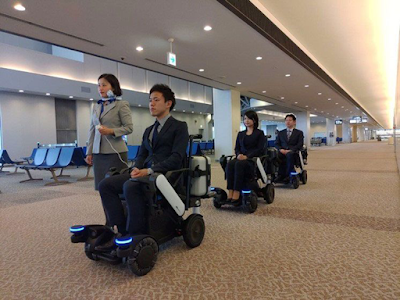According to a piece in Electronic Design, a partnership between Japan’s All Nippon Airways (ANA) and Panasonic announced a plan to develop and test autonomous wheelchairs for use in Tokyo's Narita International airport. Wheelchairs are already provided for travelers who require them, but the new motorized wheelchairs will be intelligent and autonomous.
These wheelchairs will be capable of safely navigating through the airport independently. Jointly developed by Panasonic and WHILL Co. Ltd., the wheelchairs are able to detect and avoid and obstacles on the way to their destinations. Front- and rear-mounted cameras and sensors provide wide angle visibility and obstacle detection.(Style Note: I don't know how they'll feel if we call them WHILL chairs.)
Pre-collected map data is compared against current driving situations to create the safest and optimal route for the rider. In the event an object unsafely enters its pathway, an auto-stop function will prevent a collision. For further assurance of safety at Narita, the self-driving electric wheelchairs will operate by following a predetermined leader to a common destination (see figure), and ANA staff will be on hand to serve as guides.
The chairs have several novel features, including a smaller turning radius than a typical wheelchair due to an innovative front wheel that doesn't swivel like a caster, as wheelchair front wheels typically do.
WHILL’s Personal EVs, which can travel up to 12 miles indoors or outdoors between charges, run at up to 5 mph, and climb obstacles up to two inches in height. Omnidirectional wheels roll forward like normal wheels, but also can slide sideways without skidding during turns. Conventional omnidirectional wheel technology was invented for vehicles such as forklifts. However, according to WHILL, it hasn’t been applied effectively for wheelchairs and mobility devices due to several design flaws in previous implementations.The important part here, IMO of course, is that the system will test the software in an environment that will limit accidents to minor injuries. I've never been to Tokyo Narita, but think of the crowds in places like Atlanta Hartsfield or similar hubs and the throngs of people in apparently Brownian, random motion. If the software can handle that chaotic situation, it's a good step toward handling the chaotic systems driving on roads will require.
The omnidirectional front wheels engineered by WHILL use 24 small rollers that collectively create one large wheel. The rollers all move individually, allowing the EV wheelchair to glide sideways and achieve a tighter turning radius, while simultaneously providing greater terrain coverage.

(Robot voice:) I. AM. SORRY. I. RAN. INTO. YOUR. ANKLE. WOULD. YOU. LIKE. ME. TO. ORDER. A. WHILL. CHAIR?
ReplyDeleteNot a bad way to test the software. And Japan is probably a good place to do so.
ReplyDeleteI'm not sure what the civil liability laws are like there but they can't be nearly as bad as they are here. Because these chairs WILL screw up and they WILL hurt people.....And if that were to happen here the legal shenanigans would quickly end the testing. Of course an airport concourse has a LOT of differences compared to a multi lane highway. So the testing will be indicative but not good enough to use as proof of adequacy.